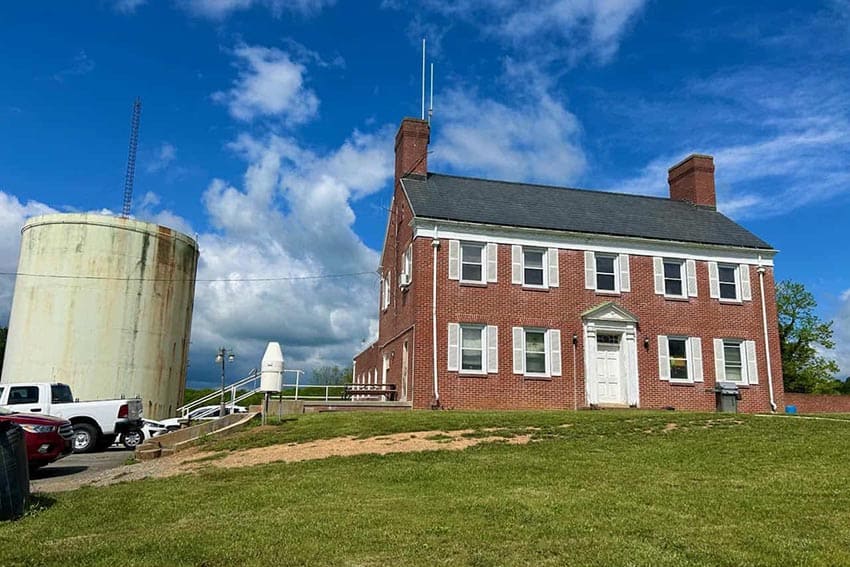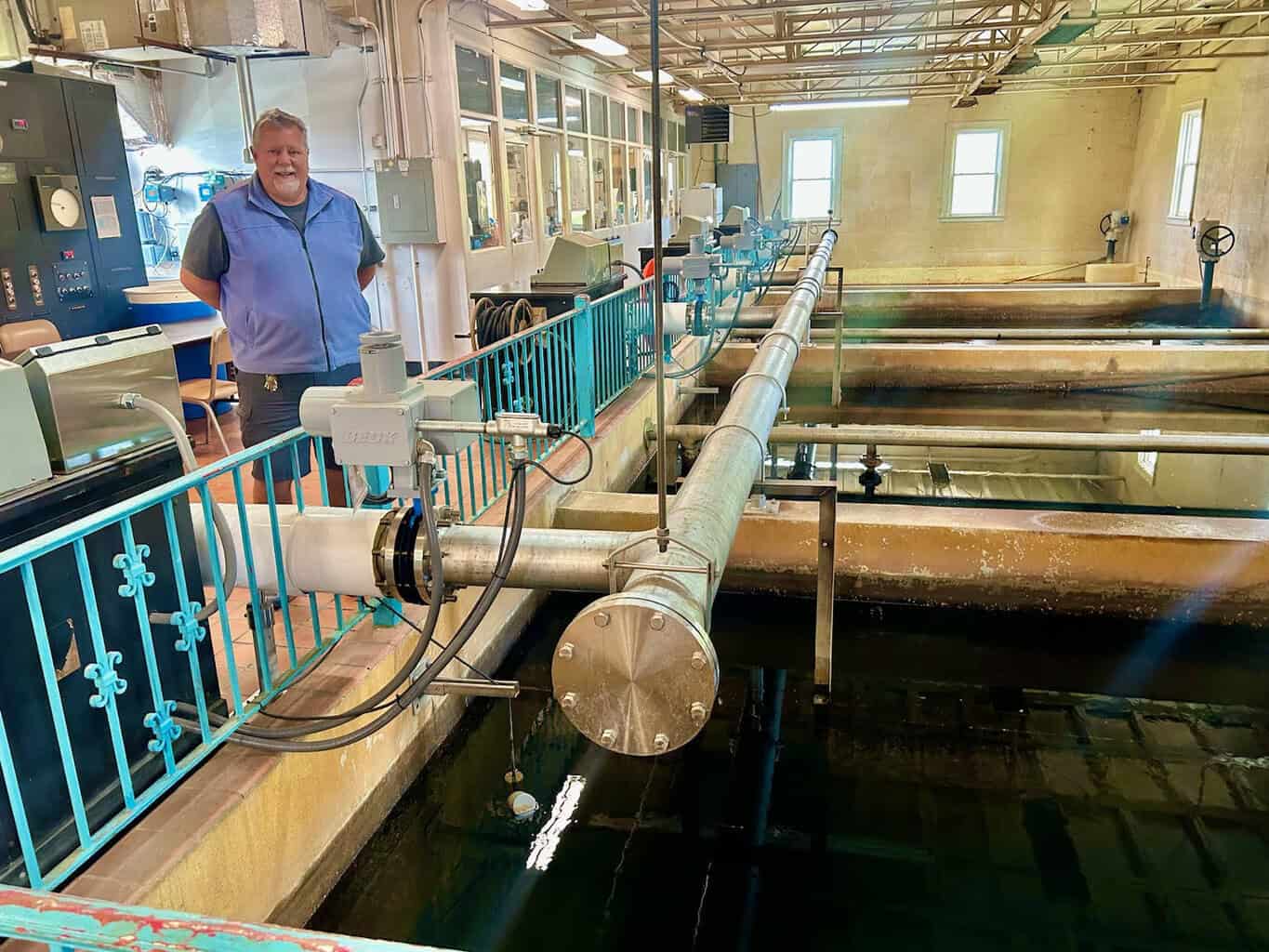Pulaski water plant due for major renovation at a cost of $25 million

Town of Pulaski Water Plant on 911 Randolph Ave. was built to look like a large house. The water tank next to it was recently repaired. (William Paine photos/Patriot Publishing)
By WILLIAM PAINE
Patriot Publishing
The Town of Pulaski will soon be asking its water customers to pay higher rates to make major renovations to the existing water purification system. The cost for this water system upgrade is estimated to be $25 million.
Pulaski Town Manager Todd Day and Dave Peyton, Chief Operator of the water plant, recently provided some insight as to why the plant needs immediate renovations.
As is well known, the Town of Pulaski’s water plant, which was built in 1951, appears to be a large brick home at first glance.
“They made it that way to blend in with the rest of the neighborhood,” said Peyton.
A huge water tank next to the plant shows signs of its age.
“We got a grant to fix that tank,” said Day. “Up until three months ago, water was shooting out the side of that. You could take a shower under there.”
Four 15 foot deep and 21 feet long filter chambers greet visitors as they pass through the front doors of the plant.
“These are our filters,” said Peyton. “Each one is capable of handling one million gallons of water a day, so we have a four MGD (million gallons a day) plant. This is the final stage. Here the water is filtered through a sand and anthracite coal media base before it goes through stainless steel laterals and becomes finished water. It goes to our clear well downstairs. That’s where we disinfect the water with chlorine/sodium hypochlorite.”

“See this panel here?” Todd Day asked as he pointed to a large electric cabinet. “This panel came over in Noah’s Ark! One of the biggest issues with this plant that is forcing us to move into this capital improvement project is you can’t buy parts. They don’t even make these gauges anymore. It’s all antiquated stuff. An upgrade would come with more efficient use of electricity.”
“There’s more technology in your cell phone than there is in this whole plant,” said Peyton with a chuckle.
The Pulaski water plant began operations in 1952 using a sedimentation basin method of straining out impurities before sending water into the filter chambers, but this changed in 1988 when a pulsator system was installed.
“They took the sediment basin system offline and put in the pulsator system as a temporary measure, so they could upgrade this,” said Day. “Then manager turnover, council turnover and it never got done.”
As a result of this change in processing, the sediment basins were emptied and the pulsator system has been in use ever since. Though water quality has remained relatively high through the years, problems in the system are becoming more evident.
The back wall or weir wall of the filter chambers are visibly eroded, as can be seen standing from above the overgrown sediment basin.
“Look at the weir wall!” Day implored. “You don’t have to be an engineer to see that we could have a catastrophic failure at any time. Those weir walls at the back of those filters are cracked and busted up You can see how they’ve been patched and patched again. What happens is freezing-thawing, freezing-thawing and it’s eventually going to give it up. This plant has held off as long as it can hold off. There’s no more holding off to this plant.”
“If that wall fails, then I can’t get water from the pulsator into the filters, and I can’t treat water,” said Peyton.
Shoring up the weir wall on the back of the filter containment basins would occur during the multimillion-dollar upgrade. Under this plan, the two existing sedimentation basins would be completely rebuilt and transformed into four separate basins.
The main thrust of the rehabilitation effort will be to replace the pulsator system, which has become problematic.
“I would say 90 percent of your water plants operate using a sedimentation basin,” said Peyton. “We’re only one of three water plants in the state that use the pulsator system. The bottom line is it takes a lot of experience and knowledge to know how to run one. We can’t hire operators from other plants because they basically have to start all over. We can’t get operators to come because nobody knows anything about a pulsator system and they just go somewhere else. So, we’re fighting that too. People capable of running a pulsator system are getting older and retiring.”

Both a pulsator and a sedimentary basin serve the purpose of binding impurities with a coagulant in a process known as flocculation.
“The floc is white stuff that looks like snow,” said Peyton of this process. “It coagulates then gets on the plate and builds up and builds up until it slides down and then we pump it out. Then we have sludge extraction and that ends up going down to the pond. We drag this 2 by 8 board across the top of the water about every other day to clear the water.”
“We’re the only water plant in the Commonwealth of Virginia that you’ve got to wear a life vest to work when you drag a two by eight board on the cord, across the top of it,” said Day. “That’s what we call modern technology!”
A brick structure at the back of the plant serves as the Chemical Building. Inside are two large tanks, one for the coagulant – or floc – and another containing sodium hypochlorite (industrial bleach) used for killing germs. Several tubes attached to pumping devises are hooked up behind the tanks. Across the room, a large funnel feeds into another container connected to still more tubes.
“We feed 50-pound bags of soda ash into the feeder,” said Peyton. “It goes into the lime silo and that volumetric feeder feeds out into the water. It boosts alkalinity and pH of the water. We were adding like 300 pounds a day to boost the pH up.”
In addition to upgrades at the water plant, the $25 million renovation project will also include renovating the pump station at Peak Creek and the two-and-a-half mile feeder pipe that brings water from the creek to the water plant.
“The raw water pump station intake sits right in the middle of the creek and gets clogged up all the time,” said Day. “When it gets clogged up, you cannot get to it. It needs to be upgraded too.”
“Some of those water lines are from 1898 to 1905,” added Peyton.
“The line that gets the water from here to the plant is leaking like a sieve,” said Day, adding that a major break in the line occurred just last year.
What kind of shape would the water plant be 10 years from now if no upgrades were made?
“It ain’t going to make it,” declared Peyton. “That (weir) wall could fail today and it would be a year before we had water. People need to understand that we have things going on that could be catastrophic, and it’s not a few days or a week.”
“My engineering background helps me see what I’m looking at,” said Day. “It helps me see the need. What’s happened is, you’ve had engineers on multiple occasions in the past come to council, made a presentation and given council an option. They said, this is what y’all need. What do you think?”
“I didn’t do that,” Day continued. “I said look, having an option is no longer an option. This has got to be done, or we’re going to lose our infrastructure. When you lose a plant, that doesn’t just mean you can’t drink water or flush your toilet, it means that I lose every business in town. We lose revenue and the economy stops.”
After all these upgrades, will the quality of the town’s water improve?
“Oh, I’ll guarantee that,” said Peyton. “It’ll be some of the best water in the state of Virginia because you have pristine source water and with young people coming on board, it’s much easier to run a conventional plant.”

How is this to be done?
“We won’t start this project for 2 ½ to 3 years,” said Day. “So, it will be a three-year rate hike. When the revenue comes in, we’ll put that revenue in a bank account in Richmond, called a VIP account that gains higher interest. When the debt service payment comes due in three years, we’ll have the money there to make the debt service payment the first year.”
Increase in water and sewer rates for the Town of Pulaski are listed in this issue of The Patriot and The Southwest Times. The debt service payment will likely extend 25 years, but according to Day the principle could well be reduced.
“I figured our debt service payment and our rate structure is based on 30 percent principal forgiveness,” said Day. “The rate structure is not designed to have to pay back $25 million in debt service. I calculated in that we’re going to get about 30 percent principal forgiveness, which is typically what the health department is doing right now. Especially since we’re under a consent order.”
Is “debt forgiveness” common?
“Happens all the time,” said Day. “Pretty normal. We’ll know in four or five months. I can’t say it’s guaranteed, but I feel really confident about it.”


May 15, 2025 @ 9:26 pm
why wait until it got in this condition? where has the town manager and town council members been? do they ever go around and look at things in the town that need looked at??
May 16, 2025 @ 6:10 am
its time to start town budget all over and start cutting there is a lot that can be cut freeze all also on the land to be develop why do we have to give a building away to get it done never give it up remember this company is here to make money not friends also where you going to put fire truck that is in the building think about it
May 16, 2025 @ 8:06 am
Which elected officials have neglected their responsibilities since the last infrastructure upgrade? Essential projects like water and sewer improvements should have already been budgeted—after all, that is why we elect these individuals in the first place. Their failure to plan and execute reflects incompetence at the highest level.
Consider their decision to remove safe and effective traffic lights in downtown Pulaski, altering road patterns and creating unnecessary confusion. Todd Day himself declared, “That’s what we call modern technology!” Yet these actions have effectively set our town back a hundred years.
And now, suddenly, they’re concerned about implementing “modern technology” when it comes to the water system? Why the concern now, when they’ve already reversed decades of progress in other areas? If they truly reject innovation, why not just dig communal wells around town and tax us to death for those too?
This level of leadership is not just disappointing—it’s disgraceful.
Eugene Mathena
May 16, 2025 @ 9:10 am
Essential water systems in town are crumbling but you better bet the social services and dope clinic have full funding to give free rides for drug users to get their daily fix. Vote for the donkey, get an a$$.